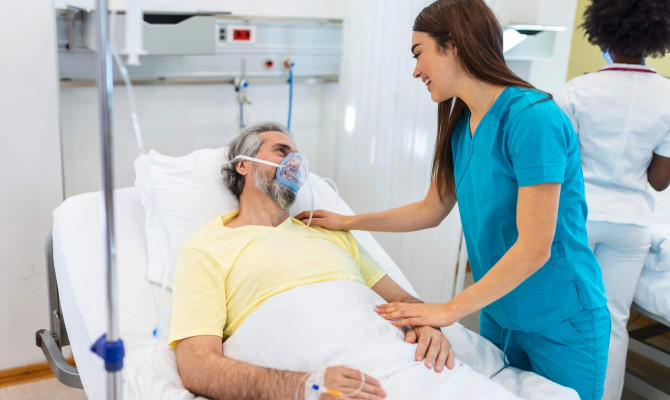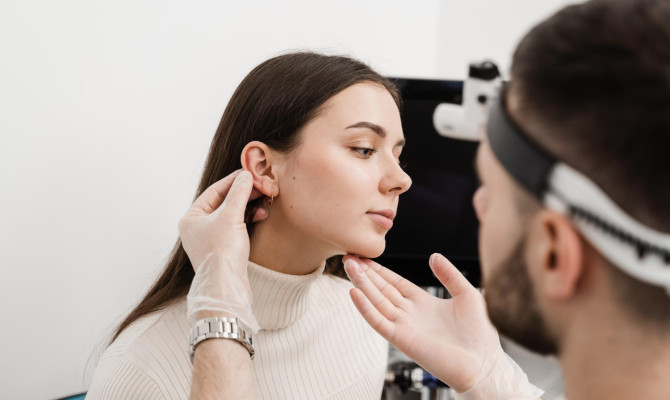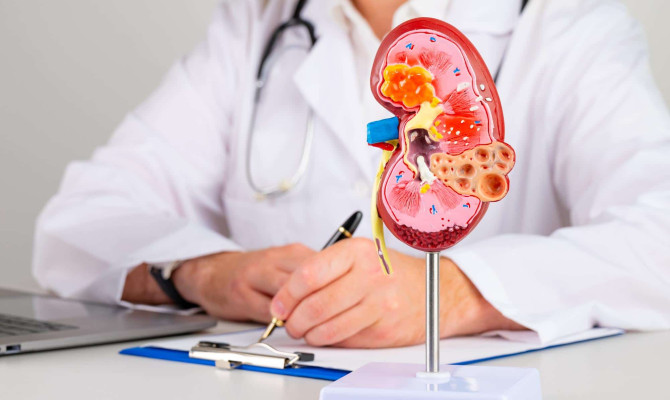Anaphylaxis: Reasons and Treatment

- Anaphylaxis
- 14 Aug 2023
Overview
What is anaphylaxis?
Anaphylaxis is an allergic reaction in the body that can sometimes be fatal. An allergic reaction is an immune response; the body produces against certain substances such as herbs, peanuts, medicines or bee venom.
Anaphylaxis activates our body’s immune system to release an excess amount of certain chemicals known as histamine, which causes a lowering of our blood pressure, narrowing of the nose airways, and difficulty breathing. Immediately the person experiences skin irritation, nausea, vomiting, and low pulse.
An allergic reaction can become exceedingly serious and result in anaphylactic shock in a person. Anaphylactic shock is the excess allergic reaction in the entire body, causing severe reactions such as inflation of bronchial tissues (which carry air to the lungs) and hypotension (low blood pressure), leading to noisy breathing and even fainting. However, anaphylactic shock patients require immediate medical attention to save their lives.
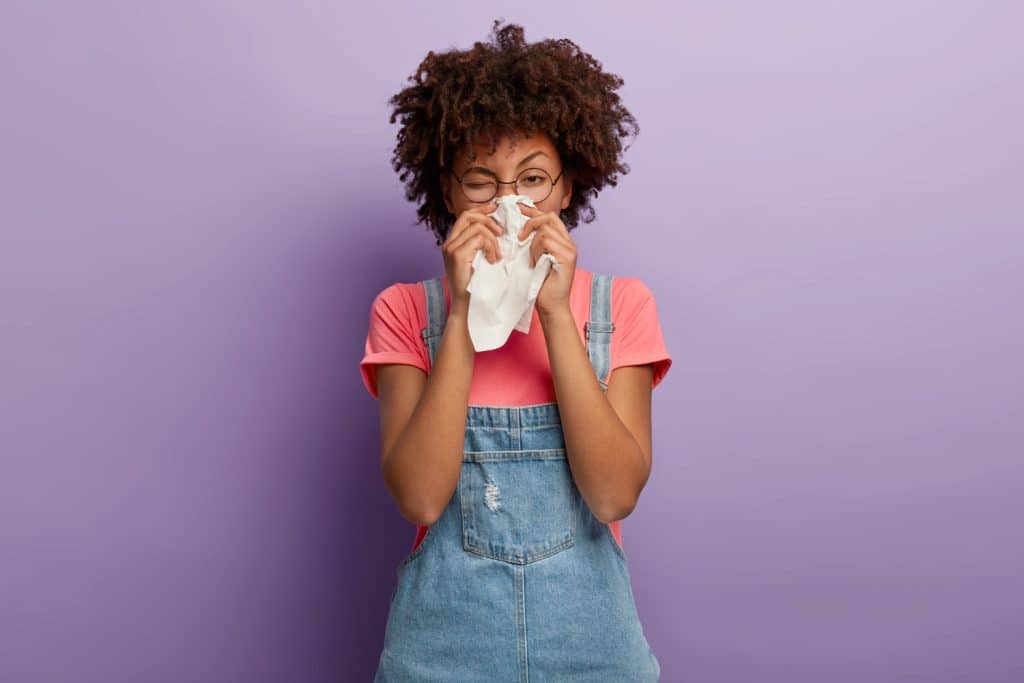
Immunity
Understanding the Immunity
Immunity is the body’s response to antigens by creating certain proteins known as antibodies to block the entry of foreign substances.
Pathogens, poisons, or chemicals that are foreign to the body are examples of antigens. In addition, antibodies are immunoglobulin (Ig) proteins made by the plasma cells in our bodies (a type of immune cell).
When an antigen enters our bodies, the immune system responds by creating antibodies to destroy the pathogen (antigen) and shield our bodies from infection.
Difference
Difference between Anaphylactic reactions and Allergy
Anaphylactic reactions are life-threatening reactions due to exposure to certain substances (allergens), producing excess chemicals called histamine to fight the infection.
While allergy is the body’s immune reaction to any foreign particle or material that enters our body, the chemical released to battle the invading substance generates specific, minor symptoms that are known as allergic reactions.
Classification
Anaphylactic reactions/ Classification
Allergic reactions are classified into the following categories-
- Type I or anaphylactic reactions,
- Type II or cytotoxic reactions,
- Type III or immunocomplex reactions, and
- Type IV cell-mediated reactions
Type I or anaphylactic reactions, Type II or cytotoxic reactions, Type III or immunocomplex reactions are the immediate types of allergic reactions because the allergic reaction occurs very fast within a time interval of one day. On the other hand, Type IV cell-mediated reactions are referred to as delayed allergic reactions because the allergic reaction occurs only after the completion of one-day exposure.
Type I or anaphylactic reactions
IgE antibodies of the body’s immune system produce Type I or anaphylactic reactions. This reaction is initiated mainly due to allergens like dust, pollen or certain food products. These substances activate our immune system to produce certain chemicals, such as histamine, causing anti-allergic reactions such as skin itching, swelling, body rash, and inflammation. Some instances of Type I or anaphylactic reactions are-
- Food allergies (viz; milk, egg, shellfish etc.)
- Eye infection (Conjunctivitis)
- Skin infection
- Asthma (narrowing of airways and causing breathing problems)
Type II or cytotoxic reactions
The allergic reaction is initiated by proteins called IgG and IgM antibodies. The antibodies damage cells by activating a type of immunity called the complement system.
- Examples of Type II allergic reactions are autoimmune hemolytic anemia and autoimmune neutropenia.
Type III or immunocomplex reactions
Type III reactions are initiated by IgM and IgG antibodies. These antibodies interact with foreign substances to form antigen-antibody complexes responsible for the response.
- Some examples of Type III allergic reactions are lupus and Arthurs reaction.
Type IV or cell-mediated reactions
Type IV allergic reactions typically take 2 to 3 days or longer to come into view after contact with the foreign substances and show cell-mediated reactions (type of immune response).
- Examples of Type IV or cell-mediated reactions are fungal infections and tuberculosis 1Classification of anaphylactic reactions | Researched based study from nih.gov
Symptoms
Symptoms of anaphylaxis
The symptoms of anaphylaxis may show up within a few minutes after exposure to an allergic substance. In some cases, the symptoms may appear after 30 minutes, while in less common cases, it may take hours to see the visible signs. Some of the symptoms of anaphylaxis are as follows-
- Skin irritation (rash)
- Hypotension
- Narrowing of airways causing difficult breathing
- Inflamed tongue or throat
- Lightheadedness
- Nausea and vomiting
- Low pulse
- Indistinct speech
- Swelled face
- Swelled lips
- Anxiety
- Stomach pain
- Diarrhoea
- Rapid heart rate
- Tiredness
- Confusion, and
- Fainting 2Symptoms of anaphylactic reactions | Researched based study from sciencedirect.com
Reasons
Reasons of anaphylaxis
The reason for anaphylaxis is the over-activation of our body’s immune system to particular products or substances our body is sensitive to.
Some common substances that can cause anaphylaxis in children are as follows-
- Milk
- Eggs
- Peanuts
- Latex
- Shellfish
Some common substances that can cause anaphylaxis in adults are as follows:
- Insect venom
- Medicines (such as penicillin, aspirin and other painkillers)
- Latex(a white liquid substance secreted from certain plants such as the rubber tree )
- In rare cases, physical exercise (walking, running, jogging or other aerobic exercises) can trigger anaphylaxis in adults.
Other reasons for rigorous anaphylaxis are as follows:
- A hereditary history of anaphylaxis
- A prior anaphylactic reaction
- Asthma (shrinking and swelling of airways causing breathing discomfort)
Suppose a person cannot analyze the cause of their anaphylaxis attack. In that case, it is always advisable to approach and consult a healthcare professional for further treatment, who might also recommend an allergy test.
An allergy test is a blood test which measures the level of IgE (immunoglobulin E) in our blood, and immunoglobulin E is a protein our body makes to fight infection in our body 2reasons of anaphylactic reactions | Researched based study from sciencedirect.com
Treatment
Treatment of anaphylaxis
In case of severe anaphylaxis, an emergency clinic visit is very necessary,
- Epinephrine auto-injector should be injected (usually in the thigh area) immediately when symptoms appear. These injections work rapidly to set aside the severe symptoms. Patients should strictly avoid any oral medication in case of trouble breathing.
- Even if the patient’s condition improves after taking the epinephrine auto-injector, he must still take the medical consultation. There’s a considerable risk of the anaphylactic reaction returning as soon as the medicine’s effects subside.
- The person must remove the sting if an anaphylactic shock is due to an insect bite. To remove the insect sting, a plastic card should be pushed against the patient’s skin, sliding it upward toward the stinger without squeezing it, as it may release additional unreleased venom from the sting.
- If someone appears to be in a state of anaphylactic shock even after 15 minutes post-epinephrine injection, a second dose of epinephrine injection is recommended. The patient should contact the emergency medical number as per the geographical location.
Caregivers must do the following things on priority for the patients before the ambulance arrives:
- The patient should be laid comfortably, and the legs should be elevated. The elevated leg position enables uninterrupted blood flow to the vital organs.
- Epinephrine injection should be administered immediately.
- If the patient faints, he should be laid on the side, and his mouth should be opened by lifting his chin.
- Cardiopulmonary resuscitation (CPR) should be performed instantly if the patient stops breathing until the emergency health team arrives.
Once the patient reaches the hospital, the following treatments are generally provided by the medical specialist:
- More epinephrine intravenous injections are provided.
- Antihistamines and glucocorticoid injections are also given intravenously. These medications help reduce airway swelling, relieving breathing difficulty.
- Beta-agonists such as albuterol are also given to make breathing easier.
- Supplemental oxygen is also provided to help the body get adequate oxygen if the situation demands it.
- Physicians, sideways, will also treat any complications related to anaphylactic shock.
Emergency anaphylaxis treatments (in hospitals)
If the person is in a severe condition and can’t breathe at all, medical specialists may perform the following things-
- A tube will be placed through the mouth or nose into the airway to help him breathe normally.
- Doctors might perform emergency surgical operations known as tracheostomy. Tracheostomy is a surgery to create an opening at the frontal part of the neck to insert a tube into the windpipe (trachea) to assist in breathing.
Some other treatments for anaphylactic shock include the following:
- After the patient is stable, doctors may advise antihistamine and steroid tablets to continue for a few more days to prevent further symptoms.
- Doctors may prescribe intravenous medication for good heart and circulatory system functioning. 3Treatment of anaphylactic reactions | Researched based study from nih.gov
- A follow-up check–up may be advised to the patient to give information regarding the preventive measures to avoid a future anaphylactic attack 4treatment of anaphylactic reactions | Researched based study from nih.gov
Natural Remedies
Natural remedies of anaphylaxis
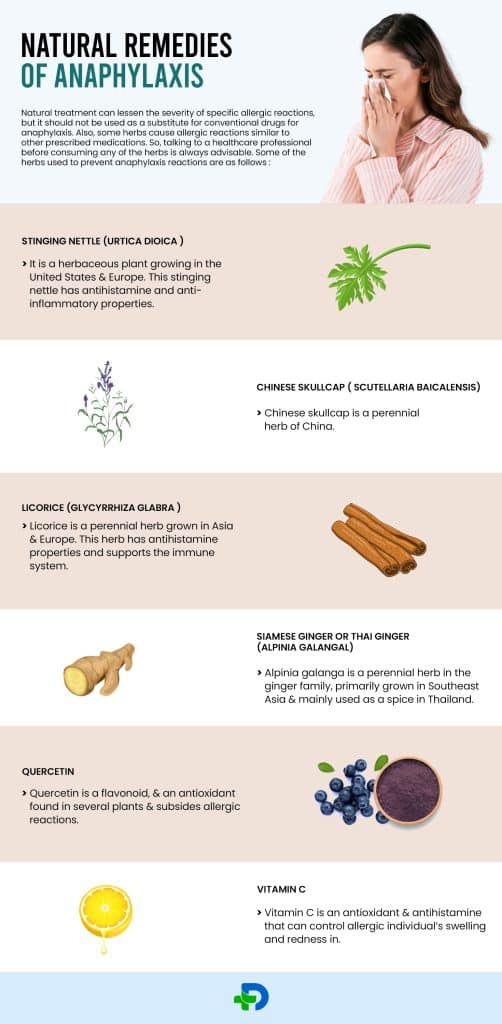
Natural treatment can lessen the severity of specific allergic reactions, but it should not be used as a substitute for conventional drugs for anaphylaxis. Also, some herbs cause allergic reactions similar to other prescribed medications. So, talking to a healthcare professional before consuming any of the herbs is always advisable. Some of the herbs used to prevent anaphylaxis reactions are as follows-
Stinging nettle (Urtica dioica )
- It is a herbaceous plant growing in the United States and Europe. This stinging nettle has antihistamine and anti-inflammatory properties. Frozen nettles, which retain most of the plant’s antihistamine properties, should only be used.
- Pregnant women and nursing mothers should avoid stinging nettle. Diabetic and nephro – patients (kidney patients) should always consult a doctor before using stinging nettle. Stinging nettle may hamper the effect of several medicines (blood pressure medications, anxiety medications etc.).
Chinese skullcap ( Scutellaria baicalensis)
- Chinese skullcap is a perennial herb of China. This herb has been traditionally used in many Chinese medicines from previous times.
- The herb has anti-inflammatory, antibacterial and antihistamine properties.
- Chinese skullcaps should be avoided by pregnant women or nursing mothers. However, Chinese skullcap can also interact with several types of medications.
Licorice (Glycyrrhiza glabra )
- Licorice is a perennial herb grown in Asia and Europe. This herb has antihistamine properties and supports the immune system. Licorice should only be used under the supervision of a doctor.
- Patients should avoid licorice , if the patient has high blood pressure, kidney and heart problem, low potassium, a history of cancers, or are expecting to have any operation within 14 days.
- Licorice can also hamper several medications, and it is always better to consult a doctor before using.
Siamese ginger or Thai ginger (Alpinia galangal)
- Alpinia galanga is a perennial herb in the ginger family, primarily grown in Southeast Asia and mainly used as a spice in Thailand.
- Studies suggest that the herb has antihistamine properties. It is available in capsules, or one can consume it as a tea drink However, Alpinia may increase the acidity in the stomach.
In addition to the herbs, the nutrients which boost immunity and prevent anaphylaxis are as follows-
Quercetin
- Quercetin is a flavonoid, and an antioxidant found in several plants and subsides allergic reactions.
- Some people get benefitted from the liquid form of quercetin ( quercetin chalcone). But, quercetin may hamper certain medications.
- Kidney patients should talk to a doctor before taking quercetin.
Vitamin C
- Vitamin C is an antioxidant and antihistamine that can control allergic individual’s swelling and redness in.
- Vitamin C also enhances the effect of quercetin. But the patients should lower the dose if diarrhea develops.
Zinc
- Zinc can improve the body’s immune system against foreign substances. Studies suggest that zinc may help control the associated symptoms of anaphylaxis nausea, vomiting, diarrhoea and stomach pain). Zinc can also interfere with certain other medicines.
Complications
Complications associated with anaphylaxis
Complications of anaphylaxis include the following:
- Heart failure
- Brain damage
- Kidney damage
- Arrhythmias (faulty electrical signals from the SA node of the heart cause abnormal heartbeat)
- Life-threatening causing death
- In some cases, there will be a deterioration of the existing medical conditions. For example, in respiratory system disorder viz; chronic inflammatory lung disease (causing obstructed airflow from the lungs), the patient may experience a lack of oxygen in the lungs causing permanent lung damage.
- Anaphylactic shock can also permanently deteriorate the symptoms of multiple sclerosis patients. However, immediate treatment for anaphylactic shock can lessen the anaphylaxis shock complications.
Thus, people should never neglect anaphylaxis allergic reactions; medical attention is the prime need to avoid fatal consequences. Also, people should be cautious about the factors that trigger their anaphylactic reaction and should try to prevent them to lead healthy and better life.
Any feedback on this article?
 This Articles content was accurate
This Articles content was accurate Very Informative Article
Very Informative Article I have a question or a comment
I have a question or a comment
 This article contains inaccurate content
This article contains inaccurate content This article was not helpful
This article was not helpful I have a question or a comment
I have a question or a comment
We appreciate your helpful feedback!
Checkout our social pages
References
-
National Institutes of Health
Anaphylaxis | Classification
-
Science Direct
Anaphylaxis - an overview | Symptoms | Reasons
-
National Institutes of Health
Anaphylactic symptoms and anaphylactic shock | Treatment
-
National Institutes of Health
Guideline for acute therapy and management of anaphylaxis | Treatment















